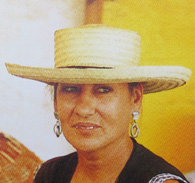Stevens, Jacquie

“Otellie taught me that each pot has its own life, personality, character and form – and that is what set me free.”
Jacquie Stevens was born in Omaha, Nebraska in 1949. She was raised by her grandparents on the Winnebago Nebraska Reservation, about 75 miles north of Omaha. The reservation borders the Missouri River so there is clay in almost everyone’s backyard. The kids all play with that clay, making little animals and unique objets d’art to play with. Much later in life Jacquie said that if she had known then what she knows now, she wouldn’t have spent so many years doing other things that ultimately had less meaning for her.
Like most female children growing up on the Winnebago Reservation, she was taught to do traditional Winnebago appliqué work on pillows, blanket shawls and ceremonial costumes. Many Ho-Chunk and Winnebago women excel at basket-making, too, but the making of pottery has never been a traditional Winnebago craft.
When she was 13, Jacquie was sent to an Indian boarding school in Flandreau, South Dakota. At 15 she was sent to the Haskell Institute (now the Haskell Indian Nations University) in Lawrence, Kansas. After graduating from there, she went to the University of Colorado at Boulder thinking to explore anthropology.
In Boulder she was exposed to aboriginal art from around the world. She saw and felt the connections from around the globe with what she had been learning and doing as a child on the reservation. The emotion that stimulated in her caused her to enroll in the Institute of American Indian Arts in Santa Fe in 1975.
She enrolled with her focus on the museum program they offered. Then she met Otellie Loloma, the Hopi woman in charge of the IAIA ceramics program at the time. During her first class with Otellie she said she felt “like I returned home; clay became my expression.”
“Otellie taught me that each pot has its own life, personality, character and form – and that is what set me free. Pottery is like people, every one is different and not perfect. I thought about this and decided it was an important idea. So I developed a new way, an unconventional way, of looking at form.” (from an interview with The Avant-Garde Magazine in 1996)
Jacquie earned her Associate of Fine Arts degree at IAIA, then earned her Bachelor of Fine Arts at the College of Santa Fe in 1981. In 1982 her work was featured in the “One with the Earth” exhibit at the Smithsonian Institute in Washington DC.
One of her pieces earned a blue ribbon at the Heard Museum Indian Arts Fair & Market in 1982. Another piece earned another blue ribbon there in 1984. In 1983 she earned a blue ribbon at the Santa Fe Indian Market. SWAIA (the Southwest Association for Indian Arts), the sponsors of Santa Fe Indian Market, awarded her a Fellowship that same year. Jacquie earned many more awards over the years and was a featured participant in many exhibitions from coast-to-coast.
Jacquie was one of the first Native American potters to coil large, intentionally off-round and free-form vessels. And while she scraped and sanded most to flawless surfaces, she wasn’t into burnishing or glazing them. Most of her clay came from the Pecos, NM area, although her love of subtle color changes in her pieces led her to test and incorporate clays she found in other places, too.
Jacquie also liked to add other materials to her pieces: wicker, woven reeds, wood, stones, leather, beads and shells. She had a unique view of the contrasts between a pure, clean form versus the disturbances caused when other materials were added. Her experimentation also didn’t stop with the pieces themselves.
Many of Jacquie’s coloring effects were created in her firing process. She often experimented with the form of the fires she built, the various (air-flow) baffles she put in place around each piece and the placement of the materials (dung, manure, pine, mesquite, juniper, etc.) she used in making the fire itself.
Some Exhibits that featured works by Jacquie
- Images, Artists, Styles: Recent Acquisitions from the Heard Museum Collection. Heard Museum North. Scottsdale, Arizona. July 2001 – January 2002
- Eight Artists II. Southwest Museum. Pasadena, California. September 27, 1987 – January 5, 1988. Note: exhibiting artists includes Clifford Beck, Jody Folwell, Bob Haozous, Robert Houle, Richard Glazer-Danay, Felice Lucero-Giaccardo, Edna Davis Jackson and Jacquie Stevens
- Women of Sweetgrass, Cedar and Sage. Gallery of the American Indian Community House. New York, NY. June 1, 1985 – June 29, 1985
- 1984 Heard Museum Guild Native American Invitational Arts Show. Heard Museum. Phoenix, Arizona. November 16-30, 1984
Some Awards earned by Jacquie
- 2004 Santa Fe Indian Market, Classification II – Pottery, Division J – Non-traditional ceramics, all materials, all techniques with or without decorative elements, any form, any design: Best of Division
- 2004 Santa Fe Indian Market, Classification II – Pottery, Division J – Non-traditional ceramics, all materials, all techniques with or without decorative elements, any form, any design, Category 1604 – Jars, wedding jars and vases, painted and unpainted, other than stoneware: First Place
- 1984 Heard Museum Guild Native American Invitational Arts Show, Classification II – Pottery, Division B – Contemporary, wheel-thrown, glazed, kiln-fired: Second Place. Awarded for artwork: Tall Pot with leather sea urchin spines